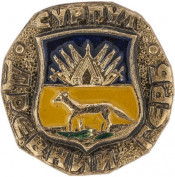
The Presidential Library marking the anniversary of Surgut
On Wednesday, June 12, 2019, residents of Surgut will celebrate the Day of Russia as well as the City Day. The administrative center of the Surgut district of the Khanty-Mansi Autonomous Area is 425 years old. The Presidential Library has formed a thematic collection "Surgut".
What is it about? Surgut was founded at the end of the XVI century, its first mention in written sources falls on the year 1594. At this time, Surgut included only a small fortress, a church, a voivode yard and a number of residential buildings. It was inhabited by the Cossacks, and in general it served as an outpost for advancing the Russian state to the east and north.
Over time, the destination of the city changed. By the end of the XVIII century, it became a major trading center. Then it acted as a place for references where the Decembrists and revolutionaries served their sentences.
The city was visited by various travelers who left memories of it. In 1891, the heir to the Russian throne, the future Nicholas II, visited Surgut.
In the 1960s, after the discovery of the West Surgut oil field, the city actually experienced a rebirth. Surgut quickly became the largest industrial, transport and cultural center of the Khanty-Mansi Autonomous Area - Yugra.
The Presidential Library’s collection, dedicated to the 425th anniversary of the founding of Surgut, includes legal acts, research, archive documents, works on statistics, periodicals, cartographic and visual materials.
One of the photographs of the “Ancient Coat of Arms” badge series features the coat of arms of Surgut, which depicts a fox in a golden field.
The Presidential Library’s collections also contain an electronic copy of plans for cities in the Tobolsk province, including Surgut, in 1801.
The “Anthropological Essay of the Ostyaks” of 1890 gives an interesting description of the climate of these places: “The climate of the region is cold; winter begins in late September and ends in May; frosts are completely 40 degrees, and 20 degrees is considered a thaw. Sharp and persistent northeastern winds increase the severity of climate. Summer is often devoid of rain, but the air is a cheese due to the extensive spills of the Ob River with its numerous channels and tributaries”.
The Sketch of Surgut Territory (1888) by S. P. Shvetsova, posted on the Presidential Library’s portal, describes the most common occupations of the local population: “The harsh climate and soil characteristics make it impossible to engage in agriculture. Meanwhile, the surrounding forests, swamps and rivers are rich in all kinds of animals, birds, fish, and the population, of course, first of all turned their gaze precisely to this side. Field studies became the main occupation, the main basis of its existence".
One of the main riches of these places is the forest. The book “Beliefs and Customs of Surgut Region” (1903) by I. Y. Neklepayev describes the “demonological views” of Surgut residents, superstitions and prejudices, ceremonies at birth and the baptism of children, divination and much more.
The collection on the Presidential Library’s portal also includes materials on the social structure, ethnic composition and population censuses, science, culture, economics, and administrative position of the territory. Thus, the “Case” of 1907 tells about the establishment of a police team in Surgut “in connection with the growth of the city’s population”.
The Surgut District of the Tobolsk Area (1925), compiled by S. A. Kuklin, contains a wide variety of statistical information relevant to the early years of Soviet power, from river accessibility to navigation to livestock.
The archive of the issues of the newspaper “Kolkhoznik” - the press organ of the Surgut Committee of the CPSU (b) and the regional council of deputies - tells about how the Surgut people lived during the Great Patriotic War.
Finally, in the author's abstract “The Surgut Cossacks at the end of the XVI-XVII centuries” A. Ulyanova notes: “In recent years we have been witnessing the process of reviving the Surgut Cossacks, whose history goes back centuries. Modern Surgut Cossacks seek to acquire a special social status, the revival of past cultural traditions. However, most of them, and indeed society as a whole, have little knowledge of the history of the Cossacks of Surgut before the beginning of the 20th century. Not everyone knows that in addition to free Cossacks, there were also serving Cossacks, and their development paths are very different. From the second half of the 1580s, the Siberian Cossacks were not free. They were public and served as service people. Thanks to Siberian, including Surgut, Cossacks and other categories of servicemen, at the end of the 16th - 17th centuries, the “Zakamenskaya country” (territory beyond the Urals) became part of the Russian state. Siberian Cossacks, including Surgut residents, fulfilled the goals and objectives set by the government...”
The postcard collection contains images of Surgut of the second half of the 20th century.
The Presidential Library’s portal includes a selection of the “Khanty-Mansi Autonomous Area - Yugra: Pages of History”, dedicated to the region of which Surgut is a part. It is included in an extensive selection of collections dedicated to all regions of our country.

